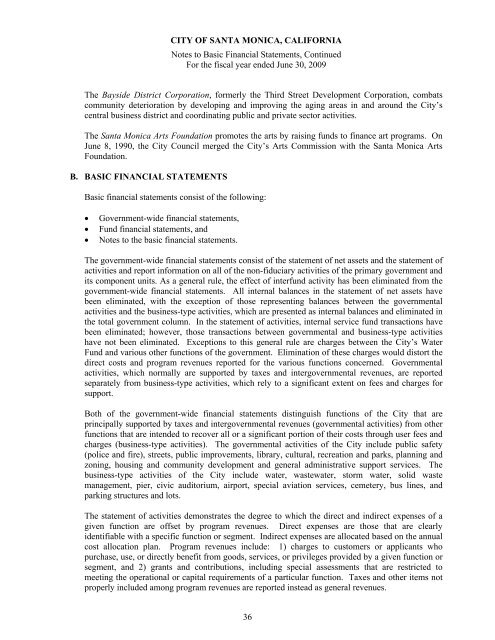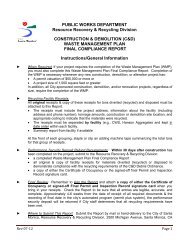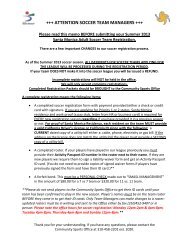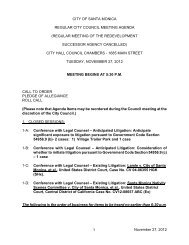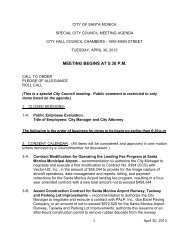Comprehensive Annual Financial Report - City of Santa Monica
Comprehensive Annual Financial Report - City of Santa Monica
Comprehensive Annual Financial Report - City of Santa Monica
Create successful ePaper yourself
Turn your PDF publications into a flip-book with our unique Google optimized e-Paper software.
CITY OF SANTA MONICA, CALIFORNIA<br />
Notes to Basic <strong>Financial</strong> Statements, Continued<br />
For the fiscal year ended June 30, 2009<br />
The Bayside District Corporation, formerly the Third Street Development Corporation, combats<br />
community deterioration by developing and improving the aging areas in and around the <strong>City</strong>’s<br />
central business district and coordinating public and private sector activities.<br />
The <strong>Santa</strong> <strong>Monica</strong> Arts Foundation promotes the arts by raising funds to finance art programs. On<br />
June 8, 1990, the <strong>City</strong> Council merged the <strong>City</strong>’s Arts Commission with the <strong>Santa</strong> <strong>Monica</strong> Arts<br />
Foundation.<br />
B. BASIC FINANCIAL STATEMENTS<br />
Basic financial statements consist <strong>of</strong> the following:<br />
• Government-wide financial statements,<br />
• Fund financial statements, and<br />
• Notes to the basic financial statements.<br />
The government-wide financial statements consist <strong>of</strong> the statement <strong>of</strong> net assets and the statement <strong>of</strong><br />
activities and report information on all <strong>of</strong> the non-fiduciary activities <strong>of</strong> the primary government and<br />
its component units. As a general rule, the effect <strong>of</strong> interfund activity has been eliminated from the<br />
government-wide financial statements. All internal balances in the statement <strong>of</strong> net assets have<br />
been eliminated, with the exception <strong>of</strong> those representing balances between the governmental<br />
activities and the business-type activities, which are presented as internal balances and eliminated in<br />
the total government column. In the statement <strong>of</strong> activities, internal service fund transactions have<br />
been eliminated; however, those transactions between governmental and business-type activities<br />
have not been eliminated. Exceptions to this general rule are charges between the <strong>City</strong>’s Water<br />
Fund and various other functions <strong>of</strong> the government. Elimination <strong>of</strong> these charges would distort the<br />
direct costs and program revenues reported for the various functions concerned. Governmental<br />
activities, which normally are supported by taxes and intergovernmental revenues, are reported<br />
separately from business-type activities, which rely to a significant extent on fees and charges for<br />
support.<br />
Both <strong>of</strong> the government-wide financial statements distinguish functions <strong>of</strong> the <strong>City</strong> that are<br />
principally supported by taxes and intergovernmental revenues (governmental activities) from other<br />
functions that are intended to recover all or a significant portion <strong>of</strong> their costs through user fees and<br />
charges (business-type activities). The governmental activities <strong>of</strong> the <strong>City</strong> include public safety<br />
(police and fire), streets, public improvements, library, cultural, recreation and parks, planning and<br />
zoning, housing and community development and general administrative support services. The<br />
business-type activities <strong>of</strong> the <strong>City</strong> include water, wastewater, storm water, solid waste<br />
management, pier, civic auditorium, airport, special aviation services, cemetery, bus lines, and<br />
parking structures and lots.<br />
The statement <strong>of</strong> activities demonstrates the degree to which the direct and indirect expenses <strong>of</strong> a<br />
given function are <strong>of</strong>fset by program revenues. Direct expenses are those that are clearly<br />
identifiable with a specific function or segment. Indirect expenses are allocated based on the annual<br />
cost allocation plan. Program revenues include: 1) charges to customers or applicants who<br />
purchase, use, or directly benefit from goods, services, or privileges provided by a given function or<br />
segment, and 2) grants and contributions, including special assessments that are restricted to<br />
meeting the operational or capital requirements <strong>of</strong> a particular function. Taxes and other items not<br />
properly included among program revenues are reported instead as general revenues.<br />
36


